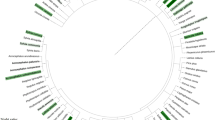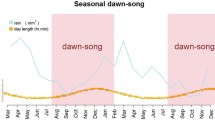Summary
Songs of a Nightingale (Luscinia megarhynchos) were recorded in front of the bird (on-axis) and simultaneously at various off-axis angles. The pattern of sound radiation in the horizontal plane around the singing bird proved to be clearly directional with a median front-back difference (0°–180°) of 4.6 dB. This deviation from omnidirectionality seems to be an inevitable result of the bird's anatomy (i. e. sound shadow effects of the head and body) but some bird species may counteract the directionality of their songs by means of behaviour. Moreover, the directional song radiation pattern might be used to direct songs towards addressees of the signals.
Zusammenfassung
Ich habe den Gesang einer Nachtigall (Luscinia megarhynchos) gleichzeitig mit einem Mikrophon frontal zum Tier und einem Mikrophon in verschieden lateralen Winkeln um den singenden Vogel herum aufgezeichnet. Anschließend wurde aus den Schallpegeldifferenzen die Abstrahlcharakteristik der Vokalisationen berechnet. Das Muster der Schallabstrahlung war deutlich frontal gerichtet und wies einen mittleren Unterschied von 4,6 dB zwischen einem Winkel von 0° (vor dem Kopf des Vogels) und 180° (hinter dem Kopf) auf. Diese Abweichung von einer omnidirektionalen Abstrahlcharakteristik ist wohl eine zwangsläufige Folge der Schallabsorption durch den Körper der Tiere. Einige Vogelarten wirken der gerichteten Gesangsabstrahlung aber möglicherweise durch ihr Verhalten entgegen, in dem sie häufig die Ausrichtung ihrer Körperlängsachse oder die laterale Ausrichtung ihrer Köpfe während des Singens verändern. Darüber hinaus könnte die Direktionalität ihrer Gesänge von Vögeln dazu benutzt werden, ihre Signale gezielt an eventuelle Adressaten zu richten.
Similar content being viewed by others
References
Au, W.W.L., Floyd, R.W. & Haun, J.E. (1978): Propagation of atlantic bottlenose dolphin echolocation signals. J. Acoust. Soc. Am. 64: 411–422.
Breitwisch, R. & Whitesides, G.H. (1987): Directionality of singing and non-singing behaviour of mated and unmated northern mockingbirds,Mimus polyglottos. Anim. Behav. 35:311–339.
Glutz von Blotzheim, U.N. & Bauer, K.M. (1997): Handbuch der Vögel Mitteleuropas. Wiesbaden.
Forrest, T. G. (1991): Power output and efficiency of sound production by crickets. Behav. Ecol. 2: 327–338.
Gerhardt, H. C. (1975): Sound pressure levels and radiation patterns of the vocalizations of some North American frogs and toads. J. comp. Physiol. 102: 1–12.
Henze, D., O'Neill, W.E. (1991): The emission pattern of vocalizations and directionality of the sonar system in the echolocating bat,Pteronotus parnelli. J Acoust Soc Am 89:2430–2434.
Hunter, M. L., Kacelnik, A., Roberts, J. & Vuillermoz, M. (1986): Directionality of avian vocalizations: a laboratory study. Condor 88: 371–375.
Larsen, O.N. & Dabelsteen, T. (1990): Directionality of blackbird vocalization. Implications for vocal communication and its further study. Ornis Scand. 31:37–45.
Miller, P. J.O. & Tyack, PL. (2001): Mixed-directionality ofO. orca stereotyped calls: a design feature promoting social cohesion. Proceedings of the 14th Biennial Conference on the Biology of Marine Mammals, p. 146.
Morgensen, F. & Møhl, B. (1979): Sound radiation patterns in the frequency domain of cries from a vespertilionid bat. J. comp. Physiol. A 134: 165–171.
Nelson, B. S. (2000): Avian dependence on sound pressure level as an auditory distance cue. Anim. Behav. 59: 57–67.
Witkin, S. R. (1977): The importance of directional sound radiation in avian vocalization. Condor 79: 490–493.
Author information
Authors and Affiliations
Rights and permissions
About this article
Cite this article
Brumm, H. Sound radiation patterns in Nightingale (Luscinia megarhynchos) songs. J Ornithol 143, 468–471 (2002). https://doi.org/10.1007/BF02465601
Accepted:
Published:
Issue Date:
DOI: https://doi.org/10.1007/BF02465601




